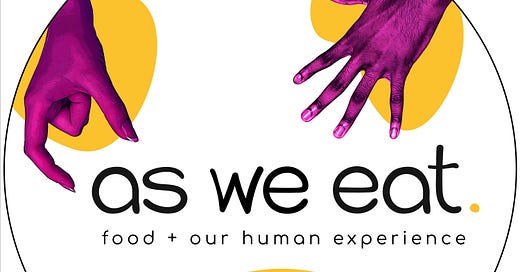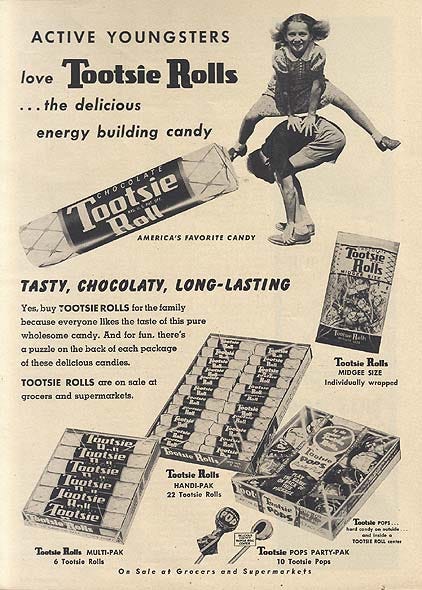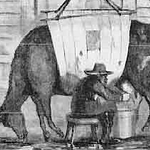Grab your plastic jack-o-lantern pumpkin trick-or-treat bucket for a trip down a ghoulishly delicious memory lane. And discover which is better: Candy Corn or Tootsie Rolls.
Halloween marks a shift from the ripening summer fruits into crisp autumn nights, all with the chilly specter of winter in the air. We mark the figurative thinning of the veil that lies between the the worlds of the living and the spirits with images of ghosts, goblins, and ghouls and sweeten the spooks with candy treats.
Reese’s Peanut Butter Cups and fun-sized chocolate bars consistently rate as Halloween candy favorites, but two older fashioned candies still show up at parties and in candy buckets - Tootsie Rolls and Candy Corn. Leigh and Kim go head to head in this episode as we explore the histories of our favorites and make our cases in Team Tootsie versus Team Candy Corn! Who will emerge victorious?
Trick or Treat?
The familiar cry of “Trick or Treat?” has its origins in Scottish and Irish mumming or guising where groups of kids and disguises went around to houses and they sang songs and begged for soul cakes, or apples or money, or really any other treat that the house owner would spare.
The earliest known occurrence of guising in North America around 1911. A newspaper in Kingston, Ontario, Canada reported on groups of children going around guising around the neighborhood. There are other references to that ritual of guising come to us from 1915 and 1920, but the phrase “trick or treat” really seemed to only appear in print for the first time in 1927 in Blackie, Alberta and then later in the United States in 1932, and by 1939, it appeared in national media.
Sugar rationing in the United States during World War II slowed the spread of the tradition, particularly from April 1942 to June 1947, but in the post war years, the idea of trick-or-treating was reintroduced via children's media in the form of magazines, books, cartoons, and family TV shows to the point that trick-or-treating was firmly re-entrenched as an American cultural tradition by 1952. Treats took the form of homemade candies, cookies, and cakes as well as nuts, coins, and small toys.
Starting in the 1950s, candy manufacturers started to embrace this trend and produced candy varieties that were more economical than home baking. This trend was followed by a preference through the 1970s and 1980s with pre-manufactured, packaged, pre-wrapped candy as a cachet item for trick-or-treaters. One of the reasons is because of the whole scare about the real Halloween boogeyman tampering with goodies - both Leigh and Kim remember stories about people passing out poisoned treats or embedding pins or razors into fresh fruits, but the reality is that these cases were extremely rare on a national scale and not necessarily limited to the Halloween holiday. Either way, it was a really fortunate urban legend for the candy manufacturers as the prevalence of homemade treats rapidly declined.
Leigh and Kim both have specific memories of going around their neighborhoods to trick-or-trick, each with an orange, plastic pumpkin bucket. For Kim, an important ritual at the end of the haul was to dump out the candy and sort through the contents, and start trading, say two Smarties for your lollipop. Certain candies obviously were favored and not to be traded. We learned a lot about commerce, the idea that some things had more value to you then to somebody else and vice versa and learning early negotiation techniques. It was pretty funny.
Speaking of favorites, Kim and Leigh each have a favorite classic Halloween candy. Kim is TEAM CANDY CORN and Leigh is TEAM TOOTSIE ROLL. We each talk about the history of our favorites in our first ever Halloween candy showdown. Which candy will emerge victorious?!
TEAM CANDY CORN
October 30th is actually National Candy Corn Day as determined by the American Confectioners Society.
Candy corn was likely invented in the late 1800s by the Wonderly Candy Company in Philadelphia, PA. Wonderly Candy itself was founded by Phillip Wonderly, a German immigrant in 1867. Wonderly and longtime employee George Renninger collaborated to produce Chicken Corn Candy with its trademark very telltale white orange, yellow, layered colors meant to represent individual kernels of corn much like you would scatter for chicken feed; agricultural themes were really popular for candy in the late 19th century.
The Goelitz Candy Company, which is later known as the Jelly Belly Candy Company, started mass producing and marketing candy corn around 1898 as “Chicken Feed.” That’s when its enduring popularity took off - it was penny candy. There's packaging from the 1920s from Goelitz featuring a proud rooster scratching around in candy bits along with the motto “King of the Candy Corn Fields”. Kim’s research also uncovered that the Goelitz candy factory suffered a catastrophic factory fire in 1950. Luckily all the employees escaped unscathed, but there was a tragic candy corn shortage that year. There was this moment in time when there was a candy corn shortage and people were worried and scared about it. The name association eventually gave way to more simple “candy corn.”
The candy corn recipe really hasn't changed much since it was first invented. The candy is simply composed of a slurry of corn syrup, sugar and water. It was made by hand as workers poured the slurry from hot 45-pound kettles into inverted triangle molds three times to form a white tip, orange center, and yellow base. When the candy hardened, the kernels were popped out of the molds and given a polishing layer. Today, it's made by machines, but interestingly, it's still the same primary ingredients making it effectively the same candy that our great-grandparents would have enjoyed.
Candy Corn has weathered 130 years of history, including two World Wars with sugar rations and a long economic depression. And even though so many people say they hate it, America’s largest candy manufacturer, Brach's produces 7 billion pieces of candy corn a year.
TEAM TOOTSIE ROLL
The Tootsie Roll was invented by an Austrian-Jewish immigrant named Leo Hershfield, and he actually did patent the whole recipe in the process of this. Leo’s father was a candy maker as well, so he took up that mantle and started making candy in Brooklyn. The Tootsie Roll is named after his daughter, Clara, whose nickname was Tootsie.
Unfortunately, Leo’s end was tragic. After he resigned or was fired from his role as Vice President of the Sweets Company of America, Leo took his life on January 14, 1922. And in 1935, the company was in dire financial straits. Joseph Rubin and Sons of Brooklyn, the manufacturer of the original paper boxes that contained the Tootsie Roll candy, decided to buy the candy company itself and managed to turn the business around.
According to the company's website, the original recipe calls for the inclusion of the previous day's batch so essentially every Tootsie Roll that you have goes back to that very first recipe that Leo Hershfield produced, which is amazing given that there are 64 million Tootsie Rolls made every single day.
Tootsie Rolls were also considered the energy bar of the World Wars, and Leigh found really cool, patriotic campaign posters about Tootsie Rolls. There were the advertisements for when the boys came home that they deserved this treat, and then in World War II, they were used to help with the energy for the troops and because they didn't melt and they were individually wrapped. It's one of the big reasons that when other confectionery companies were being rationed, this one did not because they had a government contract.
And while we cannot seem to agree whether the “almost chocolate” flavor of a Tootsie Roll is good or not, Leigh and Kim both have great memories of the Tootsie Roll Tootsie Pop commercials featuring a wise owl and a snapping turtle.
THE WINNER: TEAM TOOTSIE ROLLS
An informal poll that determined 2:1 that Tootsie Rolls were preferred to candy corn.
Kim learned that Tootsie Rolls are more than just a fun treat, it's a food item that played a really important role in our history by keeping our soldiers morale up. Leigh loved learning about the people making this treat and that there's an original piece of that candy in every one of the candies that has subsequently been produced.
Halloween Transcript
🎧 Click here for the full, interactive transcript of this episode 🎧
Sources We Found Helpful for this Episode
Books We Think You’ll Enjoy Reading
The Candy Corn Cookbook: Recipes for Halloween by Laura Sommers
Recipes You Really Need to Try
Popcorn Balls - Taste of Home
Candy Corn Jello Shots - Sprinkle Bakes
The Tootsie Roll Cocktail - Feast + West
Episodes We Think You’ll Like
School Lunches: Lunch Pails, Federal Programs, and Best and Worst Lunch Memories
Kitchen Technology: Canning, Can Openers, and Cookie Cutters
We would love to connect with you
AsWeEat.com, on Instagram @asweeat, join our new As We Eat community on Facebook, or subscribe to the As We Eat Journal.
Do you have a great idea 💡 for a show topic, a recipe 🥘 that you want to share, or just say “hi”👋🏻? Send us an email at connect@asweeat.com
Review As We Eat on Podchaser or Apple Podcast. We would like to know what you think.
And please subscribe to As We Eat, Going Places. Eric and Leigh will be traveling in their converted van sharing stories of food culture from the road.
We love sharing the As We Eat Podcast with you. Did you know that we also have an online Journal that dives deeper into food topics? For just a few dollars, you can get access to exclusive content as well as more in-depth articles and help keep our oven lights on!
Thank you for listening to the As We Eat Podcast. This post is public so share it with a friend - or three :)
























Share this post